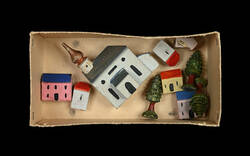Further Media
Sebastian Köpcke (*1967), Volker Weinhold (*1962) | Photographers
In the course of the Enlightenment, children were viewed as people in a phase of life in which child-appropriate play increased in importance alongside learning, education and the development of the personality. At the same time, the Christmas celebration as one of giving gifts for children also asserted itself with the ideal of the bourgeois small family. The need for child-appropriate toys grew.
In the Erzgebirge, a countless number of manufacturers had in this context been producing so-called loose and boxed goods, among other products, since the end of the eighteenth century. As the name implies, these were mass products produced for the domestic and foreign markets, for which the focus was not on attention to detail or correct proportions in the designing of buildings, figures and trees. With this toy, children could create their own little worlds and recreate everyday scenes and their own experiences.
Also significant was the fact that the miniature toy addressed both boys and girls equally. This was not self-explanatory given the separation into boys’ and girls’ toys taking place at the time. This toy also required little space and could be quickly cleared away – a fact that toy merchants were quick to advertise.
The Museum für Sächsische Volkskunst has thousands of individual parts of such miniature toys from the Erzgebirge, which were most broadly distributed between 1900 and the Second World War. Miniature toys are today sought-after collectors’ items.
Producer unknown
MATERIAL & TECHNIQUE
wood, sawed, glued, painted, turned, punched, varnished
DIMENSIONS
church H 5.4 cm, houses H 1.4 – 1.8 cm, trees H 2.7 cm
MUSEUM
Museum für Sächsische Volkskunst
PLACE, DATING
Erzgebirge, 1st half of the 20th century
INVENTORY NUMBER
G 6164
